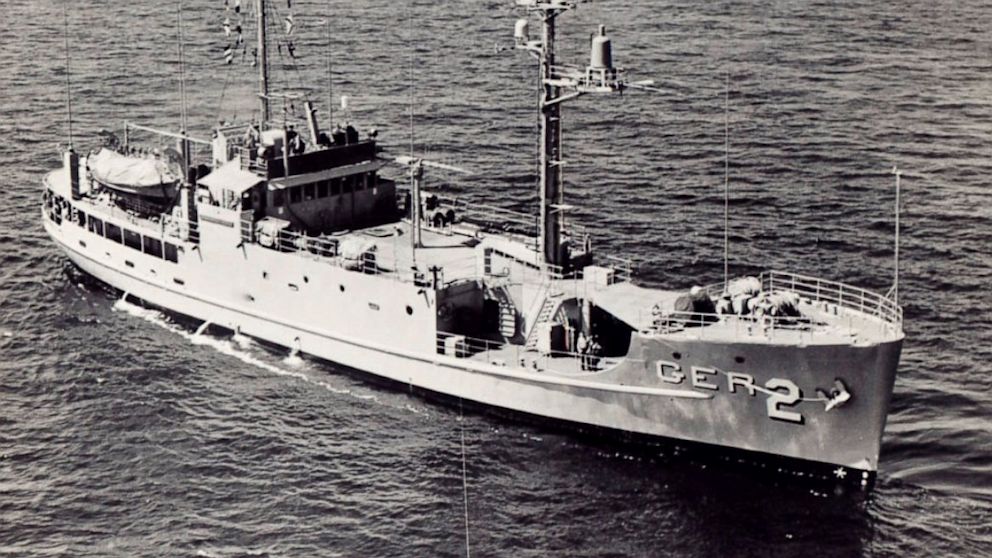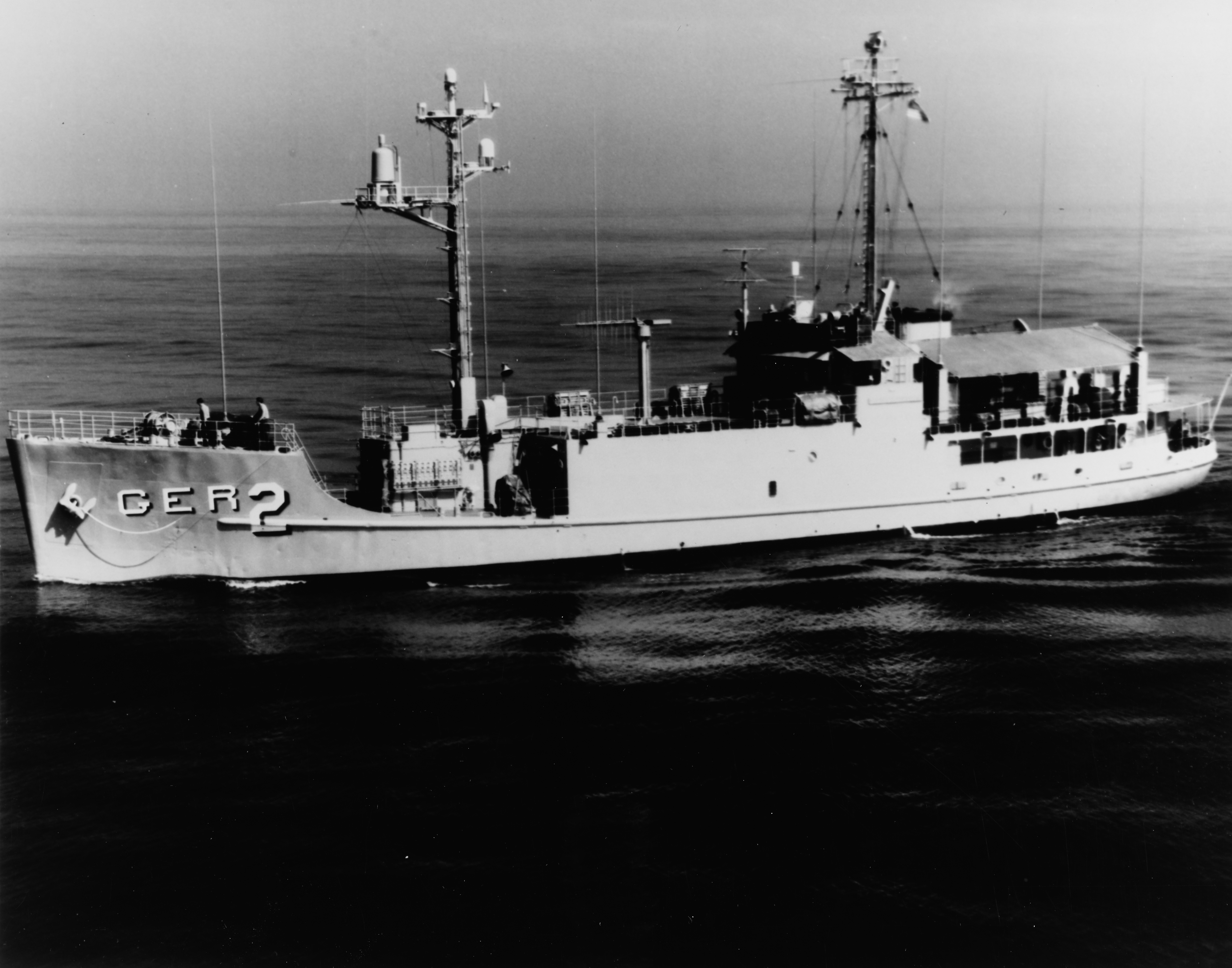N Korea to Put Captured US Ship on Display
 |
| The USS Pueblo is North Korea's greatest Cold War prize, a potent symbol of how the country has stood up to the great power of the United States. (USN/AP Photo ) |
PYONGYANG, North Korea July 25, 2013 (AP)
If there was ever any doubt about what happened to the only U.S. Navy ship that is being held by a foreign government, North Korea has cleared it up. It's in Pyongyang. And it looks like it's here to stay.
With a fresh coat of paint and a new home along the Pothong River, the USS Pueblo, a spy ship seized off North Korea's east coast in the late 1960s, is expected to be unveiled this week as the centerpiece of a renovated war museum to commemorate what North Korea calls "Victory Day," the 60th anniversary this Saturday of the signing of the armistice that ended the fighting in the Korean War.
To Read The Full AP Story click here: http://abcnews.go.com/International/wireStory/north-korea-put-captured-us-spy-ship-display-19767500
EDITOR'S NOTE; We were among the few early reporters of the disappearance of the USS Pueblo from its usual berth in North Korea. The ship was out of sight of U.S. satellite surveillance for months. There was quite a bit of speculation about its whereabouts. With the AP report linked above (the mainstream media finally tuned in) we close our file on the issue until the next episode erupts. We will however express an opinion. Frankly we should deny this lost ship as a symbol to North Korea by the equivalent of scuttling it. Since we apparently can't take it back we should destroy it. Our last dispatch concerning the Pueblo's disappearance is reprinted below. Which illustrates a second opinion that we firmly hold. Those with maritime interests need to follow maritime media, depending on the main stream media for accurate and timely reporting of naval/maritime stories. To depend on America's infotainment media outlets for maritime news is to borrow a phase from General Schwarzkopf "like going hunting without your violin". Our "NEWS SECTION" carries links to most of the world's English language maritime media. Click on the "NEWS SERVICE" for in the special interest pages listings in the right hand column opposite our daily "STATION IDENTIFICATION AND NOTICE BOARD.
2/ 23/2013
Officially the USS Pueblo, a U.S. Navy intelligence gathering ship captured by North Korea in 1968, is still a commissioned vessel of the United States Navy. She was captured by the North Koreans in International waters in 1968 and crew held captive and tortured. This low point in the Cold War known as the Pueblo Incident dragged on for 11 months before the crew was repatriated. The ship has never been returned and the United States has never relinquished any rights in it, it remains as we said, a commissioned ship of the U.S. Navy. The North Koreans had previously docked it on the Taedong River in Pyongyang as a museum. Then, as we reported several months, ago it mysteriously disappeared. There was quite a bit of speculation over what was being done with it.
EDITOR'S NOTE; We were among the few early reporters of the disappearance of the USS Pueblo from its usual berth in North Korea. The ship was out of sight of U.S. satellite surveillance for months. There was quite a bit of speculation about its whereabouts. With the AP report linked above (the mainstream media finally tuned in) we close our file on the issue until the next episode erupts. We will however express an opinion. Frankly we should deny this lost ship as a symbol to North Korea by the equivalent of scuttling it. Since we apparently can't take it back we should destroy it. Our last dispatch concerning the Pueblo's disappearance is reprinted below. Which illustrates a second opinion that we firmly hold. Those with maritime interests need to follow maritime media, depending on the main stream media for accurate and timely reporting of naval/maritime stories. To depend on America's infotainment media outlets for maritime news is to borrow a phase from General Schwarzkopf "like going hunting without your violin". Our "NEWS SECTION" carries links to most of the world's English language maritime media. Click on the "NEWS SERVICE" for in the special interest pages listings in the right hand column opposite our daily "STATION IDENTIFICATION AND NOTICE BOARD.
2/ 23/2013
WHERE IS THE USS PUEBLO?
 |
| USS PUEBLO, OFFICIAL U.S.NAVY PHOTO |
Officially the USS Pueblo, a U.S. Navy intelligence gathering ship captured by North Korea in 1968, is still a commissioned vessel of the United States Navy. She was captured by the North Koreans in International waters in 1968 and crew held captive and tortured. This low point in the Cold War known as the Pueblo Incident dragged on for 11 months before the crew was repatriated. The ship has never been returned and the United States has never relinquished any rights in it, it remains as we said, a commissioned ship of the U.S. Navy. The North Koreans had previously docked it on the Taedong River in Pyongyang as a museum. Then, as we reported several months, ago it mysteriously disappeared. There was quite a bit of speculation over what was being done with it.
We learned today ( 2/23/2013) that the ship has undergone some work and is being returned to Pyongyang where it will be a center piece for a new museum. The new museum has the rather pretentious name of Victorious Fatherland Liberation War Museum, according to the official government news service. North Korean President for Life Kim Jong Un visited the construction site recently and referred to the planned museum as a base for "anti U.S. education.
Well, we're happy to know where our ship is and to know that it still floats, even though what we want to see happen is a scuttling of the ship by U.S. agents.. Letting the North Koreans have it and exploit it while still commissioned is unacceptable. This is unfinished business. In the midst of the other tensions in the area we don't need to invade and recapture we should have done that in 1968. There isn't enough intrinsic value in the ship to risk American lives over it, but if we can kill a terrorist with a drone strike we ought to be able to sink a museum ship. Its time to scuttle her and strike her from the naval list. By keeping her in commission and allowing North Korea to display her we dishonor American sailors. Scuttle her now!
I wanted to let you know that my book about the Pueblo crisis of 1968 has just been published by New American Library/Caliber.
ReplyDeleteIt’s titled “Act of War: Lyndon Johnson, North Korea, and the Capture of the Spy Ship Pueblo.” It got starred reviews from both Library Journal and Booklist, and mystery writer Michael Connelly called it his favorite book of 2013 in interviews with the New York Times Book Review, Salon.com, and CBS’s “Face the Nation.”
Here’s a short description of the book:
In 1968, a small, dilapidated American spy ship set sail on a dangerous mission: to map military radar stations along the coast of North Korea. Packed with advanced electronic-surveillance equipment and classified intelligence documents, the USS Pueblo was poorly armed and lacked backup by air or sea. Its crew, led by a charismatic, hard-drinking ex-submarine officer named Pete Bucher, was made up mostly of untested sailors in their teens and 20s.
On a frigid January morning while listening for signals near the port of Wonsan, the Pueblo was challenged by a North Korean gunboat. When Bucher tried to escape, his ship was quickly surrounded by communist patrol boats, shelled and machine-gunned, and forced to surrender. One American was killed and ten wounded, and Bucher and his young crew were taken prisoner by the world’s most erratic communist regime. It was one of the worst intelligence debacles in U.S. history.
Less than 48 hours before the Pueblo’s capture, North Korean commandos had nearly succeeded in assassinating South Korea’s president in Seoul. Together, the two explosive incidents pushed Cold War tensions toward a flashpoint as both North and South Korea girded for possible war – with 50,000 American soldiers caught between them. President Lyndon
Johnson rushed U.S. combat ships and aircraft to reinforce
South Korea, while secretly trying to negotiate a peaceful solution to the crisis.
“Act of War” tells the riveting saga of Bucher and his men as they struggled to survive merciless torture and horrendous conditions in North Korean prisons. Based on extensive interviews and thousands of pages of government documents obtained through the Freedom of Information Act, the book also reveals new details of Johnson’s high-risk gambit to prevent war from erupting on the Korean peninsula while his negotiators
desperately tried to save the sailors from possible execution. A dramatic tale of human endurance against the backdrop of an international diplomatic poker game, “Act of War” offers lessons on the perils of covert intelligence operations as America confronts a host of 21st-century enemies.
“Act of War” is getting terrific reviews from readers around the
country. It’s available on Amazon, Barnes & Noble, and Powells.com. You can get it as a hardcover, Kindle or Nook, or audiobook. (A paperback version will be out in December.)
People have told me the book reads like a Tom Clancy novel and they appreciated learning the full story about the Pueblo for the first time. I hope you have a chance to check out “Act of War” and I’d like to hear what you thought about it. It’d make a great gift for Father’s Day or for the history buff in your family!
Here’s a link to the book’s page on Amazon:
http://www.amazon.com/Act-War-Lyndon-Johnson-Capture-ebook/dp/B00C5QQI3A
Cheers,
Jack Cheevers
Jack is a former Los Angeles Times reporter. He and his wife, Kathleen Matz, live in Oakland, California. Visit him at
www.JackCheevers.net.